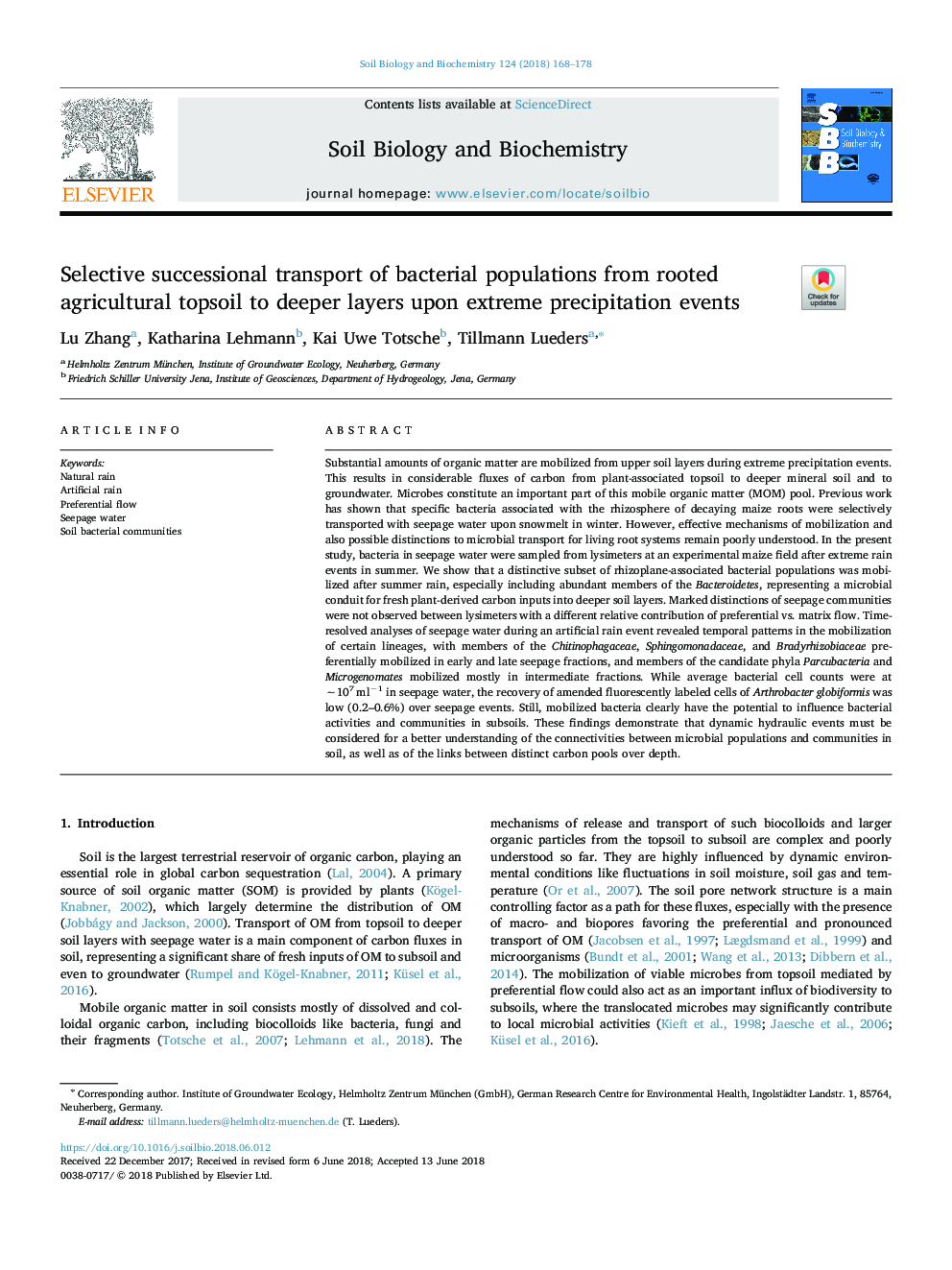| کد مقاله | کد نشریه | سال انتشار | مقاله انگلیسی | نسخه تمام متن |
|---|---|---|---|---|
| 8362575 | 1542560 | 2018 | 11 صفحه PDF | دانلود رایگان |
عنوان انگلیسی مقاله ISI
Selective successional transport of bacterial populations from rooted agricultural topsoil to deeper layers upon extreme precipitation events
ترجمه فارسی عنوان
حمل و نقل منحصر به فرد انتخابی از جمعیت باکتری از ریشه های خاکستری کشاورزی به لایه های عمیق تر پس از بارش شدید
دانلود مقاله + سفارش ترجمه
دانلود مقاله ISI انگلیسی
رایگان برای ایرانیان
کلمات کلیدی
باران طبیعی، باران مصنوعی، جریان ترجیحی آب شستشو، جوامع باکتری خاک،
موضوعات مرتبط
علوم زیستی و بیوفناوری
علوم کشاورزی و بیولوژیک
دانش خاک شناسی
چکیده انگلیسی
Substantial amounts of organic matter are mobilized from upper soil layers during extreme precipitation events. This results in considerable fluxes of carbon from plant-associated topsoil to deeper mineral soil and to groundwater. Microbes constitute an important part of this mobile organic matter (MOM) pool. Previous work has shown that specific bacteria associated with the rhizosphere of decaying maize roots were selectively transported with seepage water upon snowmelt in winter. However, effective mechanisms of mobilization and also possible distinctions to microbial transport for living root systems remain poorly understood. In the present study, bacteria in seepage water were sampled from lysimeters at an experimental maize field after extreme rain events in summer. We show that a distinctive subset of rhizoplane-associated bacterial populations was mobilized after summer rain, especially including abundant members of the Bacteroidetes, representing a microbial conduit for fresh plant-derived carbon inputs into deeper soil layers. Marked distinctions of seepage communities were not observed between lysimeters with a different relative contribution of preferential vs. matrix flow. Time-resolved analyses of seepage water during an artificial rain event revealed temporal patterns in the mobilization of certain lineages, with members of the Chitinophagaceae, Sphingomonadaceae, and Bradyrhizobiaceae preferentially mobilized in early and late seepage fractions, and members of the candidate phyla Parcubacteria and Microgenomates mobilized mostly in intermediate fractions. While average bacterial cell counts were at â¼107â¯mlâ1 in seepage water, the recovery of amended fluorescently labeled cells of Arthrobacter globiformis was low (0.2-0.6%) over seepage events. Still, mobilized bacteria clearly have the potential to influence bacterial activities and communities in subsoils. These findings demonstrate that dynamic hydraulic events must be considered for a better understanding of the connectivities between microbial populations and communities in soil, as well as of the links between distinct carbon pools over depth.
ناشر
Database: Elsevier - ScienceDirect (ساینس دایرکت)
Journal: Soil Biology and Biochemistry - Volume 124, September 2018, Pages 168-178
Journal: Soil Biology and Biochemistry - Volume 124, September 2018, Pages 168-178
نویسندگان
Lu Zhang, Katharina Lehmann, Kai Uwe Totsche, Tillmann Lueders,
